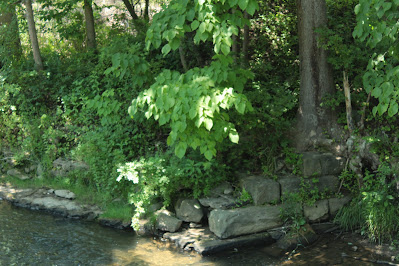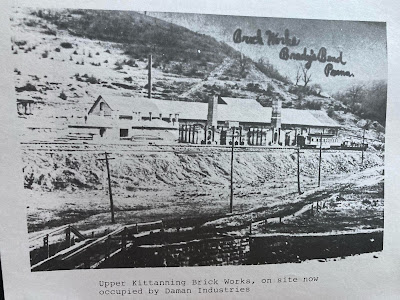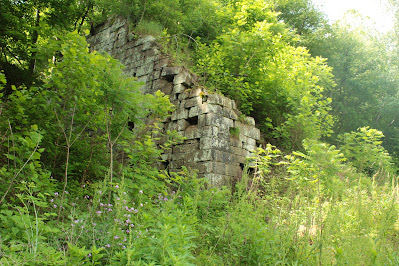Back in the 17th, 18th and 19th
centuries people of the upper classes would take a journey through Europe, as a
sort of an educational rite of passage. They visited historic spots and cities,
most often ending up in Italy. Now, in the 21st century, this custom
has fallen away but in an attempt to continue it on, I went along with a couple
friends on our own Grand Tour.
Frank Festa, Bob Davis and I had plans to visit a group of
historical structures and sites this week. Though it would only last for a half
of a day and we would never leave the state of Pennsylvania, it was still a
Grand Tour to us! Frank had compiled a list of old iron furnaces stretching
from rt.22 down to rt.30. Starting below the town of Armagh, we would follow
rt.711 south to Ligonier. If time allowed, there were three furnaces on the far
side of rt.30.
The list had 10 furnaces on it. Most were still
standing while a few were completely gone. Some had been rebuilt and taken care
of and some were being taken back by nature. The fun of the trip was seeing
what we could find. In a way, we were going back into the 19th
century!
All of these furnaces had been built in the 1800’s. They
are remnants of the early iron industry. The metal made in them was used to
make tools and other essentials needed by a growing civilization. The near-by
buildings which supported these industries are all gone, if anything only the stone
furnaces remain.
The first furnace we arrived at, the Laurel Hill Furnace, was sitting beside the road! It is huge and to
make it even easier for us, it was located on Furnace Lane. This furnace was
built in 1845 and went out of blast around 1855-1860. Over the years, the
furnace has been well cared for; trees have been removed from it preventing
destruction by the roots, a major cause of collapse, though they are starting
to re-grow once again. It has four arches, one on each side unlike most
furnaces. There was slag all over the ground around it and in the fields across
the road. We also located the stone dam that provided power to the
water wheel.
.jpg)

A couple miles further up the road, we found the Baldwin Furnace. This involved a walk
of about ¾ mile, uphill of course! Located on a state game land, the furnace is
rarely visited. Built in 1810, this has only 2 arches on it, but it has a nice
set back. (ledge) The furnace, built 35 years before the Laurel Hill furnace
is in rather poor shape. The back side has collapsed, and the chimney has fallen
in on itself.
The Hanna Furnace
was built sometime before 1810. We had references to where it was located but
they were written in the 1960’s. There are supposedly, remains still there
but we couldn’t find them. We did locate some slag, so we knew we were in the
right place.
In case you’re wondering what slag is, it is the
sludge that accumulates on top of the molten iron in a furnace. It is scrapped
off and discarded before the molten iron is poured. It is molten also and often
contains air pockets and folds and ripples in it. It often shows layers when
broken.
A mile or two further down the road we came to the Ross Furnace. What makes this furnace interesting
is that it sits on a golf course, with a putting green directly in front of it! Built
in 1815, it has been well taken care of and is in very good shape. The owners
and workers of this furnace played an important part in the Underground Railroad.
Further south we came to the Valley View (or Hillsview)
Furnace. I have always enjoyed visiting this furnace since it sits in a cow
pasture. If you’re lucky, the cows will be grazing beside it. Sadly, the cows
were across the street when we arrived.
This furnace was built 1850 and is falling in on itself. Trees and
shrubs are growing on it adding to the destruction. This structure has 4 arches
in it like the Laurel Hill furnace. It is built out of field stone making it
look much older, and not as stately as some of the other furnaces with quarried
and shaped stones.

Next on Frank’s list was the Oak Grove Furnace. This hadn’t been seen by our sources, they only
gave an approximate location. At the far end of a field beside Mill Creek we
found an old silo. Supposedly the barn was built over top of where the furnace
sat. There was slag in the field but near the silo, the brush was too thick to
see anything. A near-by hillside could have been the loading ramp. Frank, being
much more skeptical than me thinks it might have been somewhere other than near
the silo. We found the silo and some slag, so I consider it as a find!
After a stop to sample the local cuisine at a near-by Sheetz, we
went another mile down the road to a bridge crossing Mill Stream. We searched
around in the woods and on both sides of the bridge looking for any remains of the Hermitage Furnace without finding
anything. We did find some stacked stones in the stream but figured they were
part of an old bridge structure, not the furnace.
Below Ligonier we visited the California Furnace. To get there we had to drive across a nice
little covered bridge. The furnace site is set up like a small park with picnic
tables scattered around in front of the furnace. The top has been rebuilt and I
believe at one time, before being rebuilt, the complete furnace was
underground. Built in 1853, it has a nice deep stone waterway coming out from beneath
the furnace.
Returning back to rt.30 we went a few more miles up the
mountain where we came to Furnace Run Lane. We asked a worker on the property
for permission to visit the Washington
Furnace but were denied. Too many people have been sneaking down to the stream
to fish and the owners don’t appreciate it. We did see some “relics” from the
furnace though, a large solidified puddle of iron and some slag were displayed
in their driveway.
We visited a couple RR stations in Ligonier and then headed
back north to rt.22 by way of Derry where we stopped to take a few pictures of
a train. In another hour, or so, I was back home. I had been gone almost 13
hours.
We never left the continent, we didn’t cross over the “big
pond”, but we did see a lot of history in our journey. Much like the historic
spots in Europe, some of these places were well kept and complete with signage
while some of the others were only tales passed down from generation to
generation. We hadn’t been gone for a month or more and we never made it to
Italy, but to celebrate our Grand Tour, I had a plate of spaghetti before
hitting the sack!





.jpg)
.jpg)
.jpg)
.jpg)

.jpg)

.jpg)



.jpg)



.jpg)
















